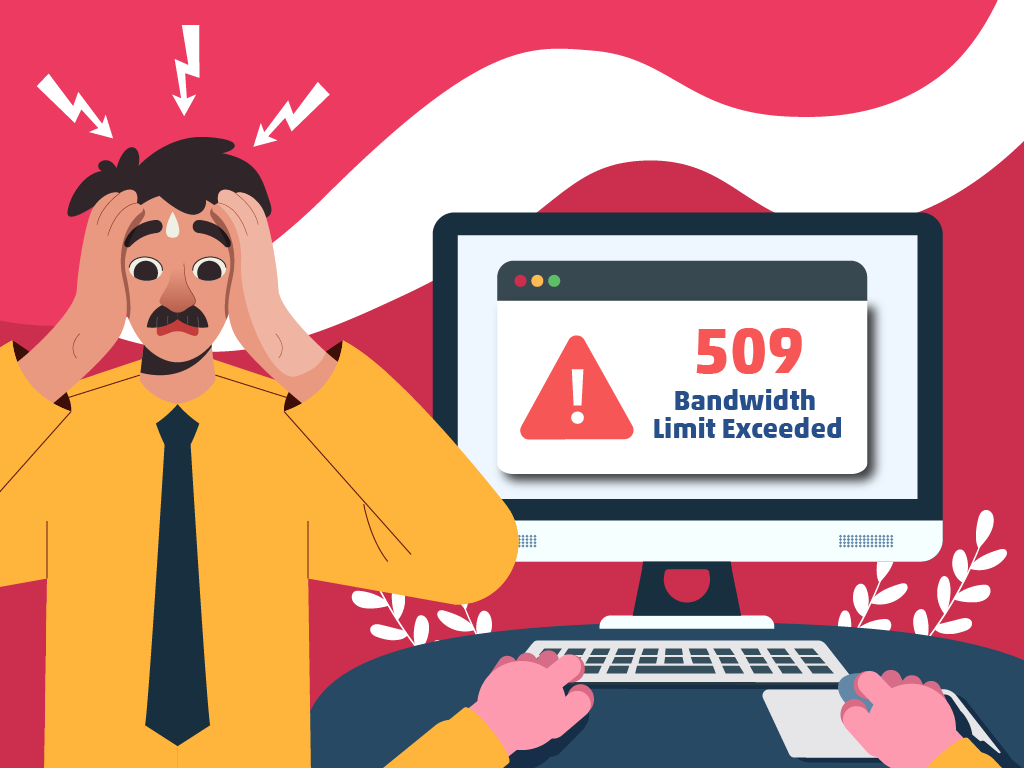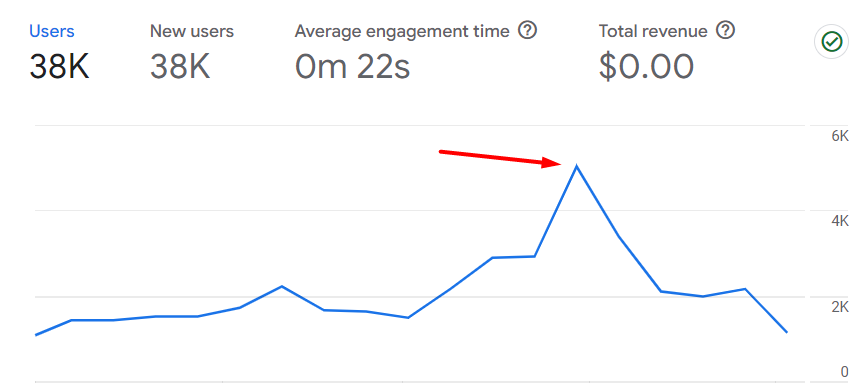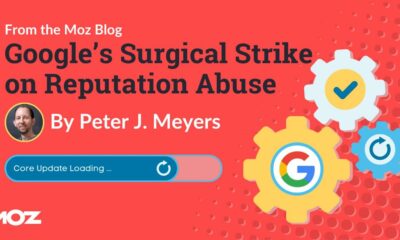SEO
What a 509 Bandwidth Limit Exceeded Error is, and How to Fix it

There are several 5xx errors you can run into when you’re running a website–one of the more common ones is the “509 Bandwidth Limit Exceeded.”
Like others in this category of status codes, it can be frustrating to see this on your screen, especially since it prevents your web pages from loading for your visitors.
The good news is that this error is easy to solve–you just need to know how to troubleshoot it. I’ll walk you through how to do it.
What is the HTTP 509 Bandwidth Limit Exceeded Error?

If you’re seeing this on your screen, it means exactly what it says in its message: that your website is using more bandwidth than your hosting plan allows.
Bandwidth is the amount of data your website can send or transfer to any user that loads it within a set period (usually per month).
That means bandwidth gets used up, bit by bit, each time a user visits your website. If you’re seeing lots of traffic, then you need more bandwidth to deliver data to those visitors. And when you reach your bandwidth capacity’s limit, the 509 Bandwidth Limit Exceeded error code appears.
But that doesn’t mean you need to get angry with your hosting provider. It’s not anything that they’re doing, it just means the plan you’re paying for is a limited hosting plan. Your website will start loading properly again once your bandwidth allowance resets.
Webmaster’s Note: This post is part of our advanced guide to Technical SEO, where I cover everything you need to know about crawlability, indexing, and page speed optimization, as well as helpful tips on how to troubleshoot common website errors. I also cover other 5xx errors, including 503 errors and 504 errors.
How to Fix the 509 Bandwidth Limit Exceeded Error
To troubleshoot this error as quickly as possible, there’s one thing you need to do: contact your hosting provider.
Do this as soon as you notice your website returning 509 Bandwidth Limit Exceeded errors. You can ask them to increase your bandwidth limit or switch to an unlimited hosting plan. The second is a good option if you’re currently using shared hosting plans.
Next, consider streamlining the files on your portal. To do this, you will have to optimize your web application by utilizing reduced data size or file compression for anything big on your website (such as photos).
You can also consider caching data, which will create a duplicate of the portal. Doing this will allow data to be fetched from the web director, rather than the back-end.
The last two options allow you to reduce the amount of bandwidth each user takes up whenever they try to load a page or click on your website.
What Causes 509 Errors?

As you’ve probably guessed by now, a 509 error is always caused by something taking up too much bandwidth before your hosting plan resets for the given period.
This can be the result of the following:
- Sudden traffic spikes – more visitors than usual going to your website (maybe as a result of a new promo or ads campaign you’re running), can quickly eat up your available bandwidth.
- Insufficient hosting resources – if the hosting plan you have, or the server infrastructure of your hosting provider is not properly configured or given enough resources, then it can limit bandwidth.
- Too big files – Certain file formats (or the files themselves) may create enormous datasets, which can consume more bandwidth than what you have available.
- Bot traffic or DDoS attacks – malicious bots and attacks can flood a website with requests, which can push you past the limit of your bandwidth allocation.
- Using a shareable hosting package – sharing a package with other websites means you share a bandwidth allowance, which these other websites can use up.
How to Avoid 509 Bandwidth Limit Exceeded Error
Luckily, problems with bandwidth allowance are something you can easily fix, so your website can avoid dealing with a 509 error again. Here are five potential solutions for you to consider:
- Use Content Delivery Network (CDN) caching
- Optimize your website files and database
- Delete any unused files
- Prepare for traffic spikes
- Increase site security
- Upgrade your hosting plan
Use Content Delivery Network (CDN) Caching
Using Content Delivery Network (CDN) caching is a good option to help you reduce the strain on your bandwidth allowance. It’s especially useful if your website is drawing in traffic from other regions or countries.
Using one allows your website to store static files on a CDN server, which improves the load time of your web pages.
Some hosting providers include CDN services in their packages, so try contacting your provider to check what they currently offer.
Optimize Your Website Files and Database
The files stored on your website, and your database can take up tons of space on your server. And if they’re not optimized, then they’re slower to load–which means they take up more bandwidth whenever a user requests them.
Any heavy files you have should be optimized. To do this, you can compress files, convert them to other file types, use smaller file sizes, or limit the number of stored items (or a combination of all these options).
Delete Any Unused Files
You can also move files to a different server, or delete them from your website altogether to free up space. Unused files take up unnecessary space on your server, so make sure to audit your files regularly to ensure your website isn’t bogged down by them.
Using a file manager or File Transfer Protocol (FTP) client to connect to your server will also make it easier to delete the files that you do not need.
Consider removing any unused plugins or themes from your website as well. You might have to ask your hosting provider to help you clean up your website.
Prepare for Traffic Spikes
It’s a good idea to provide an extra 50% capacity for your website because it allows you to be ready for any traffic spikes.
You can use SEO tools and analytics to monitor your website’s usual bandwidth usage and identify traffic patterns. This will show you what time of the day, week, month, and year you can expect more users to visit your website, and how much extra bandwidth you need to accommodate them.
Increase Site Security
Another measure to help you avoid 509 Bandwidth Limit Exceeded errors is to manage bot traffic and protect yourself against DDoS attacks.
Firewalls, rate-limiting, or working with site security services can help you protect your website from sources of malicious traffic.
Upgrade Your Hosting Plan
If, after all these measures, you are still hitting your bandwidth limit, you need to consider upgrading your hosting plan to get a higher bandwidth allocation.
Generally, you can choose to just increase your allocation per month, or get an unlimited plan. If you get the latter, you won’t have to worry about hitting your bandwidth limits at all.
If, however, you decide to get the former, you will need to calculate just how much bandwidth you need per month and choose a hosting plan that covers that number.
Remember: you can always decide to upgrade and oversize the bandwidth limit your website has, but this might not always be a good financial decision, especially when you’re just starting with your website. But if you go too low, you may run into bandwidth exceeded limit errors.
How to Calculate Bandwidth for Your Website
To calculate how much bandwidth your website needs, you first need to find the following factors:
- Average page size (APS) of your website (expressed in KB)
- Estimate the average number of daily visitors (ANDV)
- Estimate the average number of page views per visitor (ANPV)
- Extra bandwidth for possible traffic spikes.
For the average number of daily visitors and average number of page views per visitor, check your Google Analytics, under your acquisition reports. I recommend using data that Google Analytics has collected from at least the last three months.
Plug those numbers into the formula below:
ANPV x APS x ANDV x # Days in a Month (31)
Then add an extra 50% to whatever number you get. This will provide a rough estimate of how much bandwidth you need, including some legroom for any sudden spikes in traffic your website might get in the month.
How 509 Bandwidth Limit Exceeded Errors Affect SEO
Fixing a 509 error as soon as you see it is important not just for your website to work as it should–it’s also important from an SEO perspective as well.
Google might consider your website as a defunct or inactive one if you leave a 509 error unchecked for too long. So, you risk your entire website being removed from the search results. After all, why would it index and show users pages that won’t even load?
If your rankings and organic traffic matter to you, then it’s in your best interest to solve this problem ASAP.
Key Takeaway
Seeing the “509 bandwidth limit exceeded” error message can be stressful. But, it’s a problem that you can easily resolve with the right steps.
Though you can’t predict with 100% accuracy how and when your website will grow, getting a rough estimate for monthly bandwidth consumption, choosing the right hosting plan, reducing the bandwidth requirements of your site, and monitoring your traffic and site security can help you avoid seeing another 509 error on your website.
SEO
Google Rolls Out New ‘Web’ Filter For Search Results

Google is introducing a filter that allows you to view only text-based webpages in search results.
The “Web” filter, rolling out globally over the next two days, addresses demand from searchers who prefer a stripped-down, simplified view of search results.
Danny Sullivan, Google’s Search Liaison, states in an announcement:
“We’ve added this after hearing from some that there are times when they’d prefer to just see links to web pages in their search results, such as if they’re looking for longer-form text documents, using a device with limited internet access, or those who just prefer text-based results shown separately from search features.”
We’ve added this after hearing from some that there are times when they’d prefer to just see links to web pages in their search results, such as if they’re looking for longer-form text documents, using a device with limited internet access, or those who just prefer text-based…
— Google SearchLiaison (@searchliaison) May 14, 2024
The new functionality is a throwback to when search results were more straightforward. Now, they often combine rich media like images, videos, and shopping ads alongside the traditional list of web links.
How It Works
On mobile devices, the “Web” filter will be displayed alongside other filter options like “Images” and “News.”
If Google’s systems don’t automatically surface it based on the search query, desktop users may need to select “More” to access it.
 Screenshot from: twitter.com/GoogleSearchLiaison, May 2024.
Screenshot from: twitter.com/GoogleSearchLiaison, May 2024.More About Google Search Filters
Google’s search filters allow you to narrow results by type. The options displayed are dynamically generated based on your search query and what Google’s systems determine could be most relevant.
The “All Filters” option provides access to filters that are not shown automatically.
Alongside filters, Google also displays “Topics” – suggested related terms that can further refine or expand a user’s original query into new areas of exploration.
For more about Google’s search filters, see its official help page.
Featured Image: egaranugrah/Shutterstock
SEO
Why Google Can’t Tell You About Every Ranking Drop

In a recent Twitter exchange, Google’s Search Liaison, Danny Sullivan, provided insight into how the search engine handles algorithmic spam actions and ranking drops.
The discussion was sparked by a website owner’s complaint about a significant traffic loss and the inability to request a manual review.
Sullivan clarified that a site could be affected by an algorithmic spam action or simply not ranking well due to other factors.
He emphasized that many sites experiencing ranking drops mistakenly attribute it to an algorithmic spam action when that may not be the case.
“I’ve looked at many sites where people have complained about losing rankings and decide they have a algorithmic spam action against them, but they don’t. “
Sullivan’s full statement will help you understand Google’s transparency challenges.
Additionally, he explains why the desire for manual review to override automated rankings may be misguided.
Two different things. A site could have an algorithmic spam action. A site could be not ranking well because other systems that *are not about spam* just don’t see it as helpful.
I’ve looked at many sites where people have complained about losing rankings and decide they have a…
— Google SearchLiaison (@searchliaison) May 13, 2024
Challenges In Transparency & Manual Intervention
Sullivan acknowledged the idea of providing more transparency in Search Console, potentially notifying site owners of algorithmic actions similar to manual actions.
However, he highlighted two key challenges:
- Revealing algorithmic spam indicators could allow bad actors to game the system.
- Algorithmic actions are not site-specific and cannot be manually lifted.
Sullivan expressed sympathy for the frustration of not knowing the cause of a traffic drop and the inability to communicate with someone about it.
However, he cautioned against the desire for a manual intervention to override the automated systems’ rankings.
Sullivan states:
“…you don’t really want to think “Oh, I just wish I had a manual action, that would be so much easier.” You really don’t want your individual site coming the attention of our spam analysts. First, it’s not like manual actions are somehow instantly processed. Second, it’s just something we know about a site going forward, especially if it says it has change but hasn’t really.”
Determining Content Helpfulness & Reliability
Moving beyond spam, Sullivan discussed various systems that assess the helpfulness, usefulness, and reliability of individual content and sites.
He acknowledged that these systems are imperfect and some high-quality sites may not be recognized as well as they should be.
“Some of them ranking really well. But they’ve moved down a bit in small positions enough that the traffic drop is notable. They assume they have fundamental issues but don’t, really — which is why we added a whole section about this to our debugging traffic drops page.”
Sullivan revealed ongoing discussions about providing more indicators in Search Console to help creators understand their content’s performance.
“Another thing I’ve been discussing, and I’m not alone in this, is could we do more in Search Console to show some of these indicators. This is all challenging similar to all the stuff I said about spam, about how not wanting to let the systems get gamed, and also how there’s then no button we would push that’s like “actually more useful than our automated systems think — rank it better!” But maybe there’s a way we can find to share more, in a way that helps everyone and coupled with better guidance, would help creators.”
Advocacy For Small Publishers & Positive Progress
In response to a suggestion from Brandon Saltalamacchia, founder of RetroDodo, about manually reviewing “good” sites and providing guidance, Sullivan shared his thoughts on potential solutions.
He mentioned exploring ideas such as self-declaration through structured data for small publishers and learning from that information to make positive changes.
“I have some thoughts I’ve been exploring and proposing on what we might do with small publishers and self-declaring with structured data and how we might learn from that and use that in various ways. Which is getting way ahead of myself and the usual no promises but yes, I think and hope for ways to move ahead more positively.”
Sullivan said he can’t make promises or implement changes overnight, but he expressed hope for finding ways to move forward positively.
Featured Image: Tero Vesalainen/Shutterstock
SEO
56 Google Search Statistics to Bookmark for 2024

If you’re curious about the state of Google search in 2024, look no further.
Each year we pick, vet, and categorize a list of up-to-date statistics to give you insights from trusted sources on Google search trends.
- Google has a web index of “about 400 billion documents”. (The Capitol Forum)
- Google’s search index is over 100 million gigabytes in size. (Google)
- There are an estimated 3.5 billion searches on Google each day. (Internet Live Stats)
- 61.5% of desktop searches and 34.4% of mobile searches result in no clicks. (SparkToro)
- 15% of all Google searches have never been searched before. (Google)
- 94.74% of keywords get 10 monthly searches or fewer. (Ahrefs)
- The most searched keyword in the US and globally is “YouTube,” and youtube.com gets the most traffic from Google. (Ahrefs)
- 96.55% of all pages get zero search traffic from Google. (Ahrefs)
- 50-65% of all number-one spots are dominated by featured snippets. (Authority Hacker)
- Reddit is the most popular domain for product review queries. (Detailed)
- Google is the most used search engine in the world, with a mobile market share of 95.32% and a desktop market share of 81.95%. (Statista)


- Google.com generated 84.2 billion visits a month in 2023. (Statista)
- Google generated $307.4 billion in revenue in 2023. (Alphabet Investor Relations)
- 63.41% of all US web traffic referrals come from Google. (SparkToro)
- 92.96% of global traffic comes from Google Search, Google Images, and Google Maps. (SparkToro)
- Only 49% of Gen Z women use Google as their search engine. The rest use TikTok. (Search Engine Land)
- 58.67% of all website traffic worldwide comes from mobile phones. (Statista)
- 57% of local search queries are submitted using a mobile device or tablet. (ReviewTrackers)


- 51% of smartphone users have discovered a new company or product when conducting a search on their smartphones. (Think With Google)
- 54% of smartphone users search for business hours, and 53% search for directions to local stores. (Think With Google)
- 18% of local searches on smartphones lead to a purchase within a day vs. 7% of non-local searches. (Think With Google)
- 56% of in-store shoppers used their smartphones to shop or research items while they were in-store. (Think With Google)
- 60% of smartphone users have contacted a business directly using the search results (e.g., “click to call” option). (Think With Google)
- 63.6% of consumers say they are likely to check reviews on Google before visiting a business location. (ReviewTrackers)
- 88% of consumers would use a business that replies to all of its reviews. (BrightLocal)
- Customers are 2.7 times more likely to consider a business reputable if they find a complete Business Profile on Google Search and Maps. (Google)
- Customers are 70% more likely to visit and 50% more likely to consider purchasing from businesses with a complete Business Profile. (Google)
- 76% of people who search on their smartphones for something nearby visit a business within a day. (Think With Google)
- 28% of searches for something nearby result in a purchase. (Think With Google)
- Mobile searches for “store open near me” (such as, “grocery store open near me” have grown by over 250% in the last two years. (Think With Google)
- People use Google Lens for 12 billion visual searches a month. (Google)
- 50% of online shoppers say images helped them decide what to buy. (Think With Google)
- There are an estimated 136 billion indexed images on Google Image Search. (Photutorial)
- 15.8% of Google SERPs show images. (Moz)
- People click on 3D images almost 50% more than static ones. (Google)
- More than 800 million people use Google Discover monthly to stay updated on their interests. (Google)
- 46% of Google Discover URLs are news sites, 44% e-commerce, 7% entertainment, and 2% travel. (Search Engine Journal)
- Even though news sites accounted for under 50% of Google Discover URLs, they received 99% of Discover clicks. (Search Engine Journal)


- Most Google Discover URLs only receive traffic for three to four days, with most of that traffic occurring one to two days after publishing. (Search Engine Journal)
- The clickthrough rate (CTR) for Google Discover is 11%. (Search Engine Journal)
- 91.45% of search volumes in Google Ads Keyword Planner are overestimates. (Ahrefs)
- For every $1 a business spends on Google Ads, they receive $8 in profit through Google Search and Ads. (Google)
- Google removed 5.5 billion ads, suspended 12.7 million advertiser accounts, restricted over 6.9 billion ads, and restricted ads from showing up on 2.1 billion publisher pages in 2023. (Google)
- The average shopping click-through rate (CTR) across all industries is 0.86% for Google Ads. (Wordstream)
- The average shopping cost per click (CPC) across all industries is $0.66 for Google Ads. (Wordstream)
- The average shopping conversion rate (CVR) across all industries is 1.91% for Google Ads. (Wordstream)
- 58% of consumers ages 25-34 use voice search daily. (UpCity)
- 16% of people use voice search for local “near me” searches. (UpCity)
- 67% of consumers say they’re very likely to use voice search when seeking information. (UpCity)
- Active users of the Google Assistant grew 4X over the past year, as of 2019. (Think With Google)
- Google Assistant hit 1 billion app installs. (Android Police)
- AI-generated answers from SGE were available for 91% of entertainment queries but only 17% of healthcare queries. (Statista)
- The AI-generated answers in Google’s Search Generative Experience (SGE) do not match any links from the top 10 Google organic search results 93.8% of the time. (Search Engine Journal)
- Google displays a Search Generative element for 86.8% of all search queries. (Authoritas)


- 62% of generative links came from sources outside the top 10 ranking organic domains. Only 20.1% of generative URLs directly match an organic URL ranking on page one. (Authoritas)
- 70% of SEOs said that they were worried about the impact of SGE on organic search (Aira)
Learn more
Check out more resources on how Google works:
-

 SEO6 days ago
SEO6 days agoHow to Use Keywords for SEO: The Complete Beginner’s Guide
-

 MARKETING7 days ago
MARKETING7 days agoHow To Protect Your People and Brand
-

 MARKETING4 days ago
MARKETING4 days agoAdvertising on Hulu: Ad Formats, Examples & Tips
-

 WORDPRESS5 days ago
WORDPRESS5 days agoBest WordPress Plugins of All Time: Updated List for 2024
-

 MARKETING5 days ago
MARKETING5 days agoUpdates to data build service for better developer experiences
-

 MARKETING2 days ago
MARKETING2 days ago18 Events and Conferences for Black Entrepreneurs in 2024
-

 MARKETING6 days ago
MARKETING6 days agoThe Ultimate Guide to Email Marketing
-

 WORDPRESS5 days ago
WORDPRESS5 days agoShopify Could Be Undervalued Based On A Long-Term Horizon















